The Pomegranate is one of the essential fruit crops grown in India. Since Pomegranate farming originated in Iran, it has been extensively practiced in Mediterranean countries like Iran, Spain, Morocco, Egypt, Afghanistan, and Baluchistan. Pomegranates are produced in large quantities in India. Fresh fruits are used for table purposes, including Pomegranates, also favorite table fruits.
Additionally, they can prepare juice, syrup, squash, juice concentrates, jelly, anar rub, carbonated drinks, anar dana tablets, acids, etc. There are fewer acids in the seeds of these fruits. Those seeds can even be eaten. Fruits grown in Spain and Iran are much inferior in taste and attractiveness to those grown in the United States.
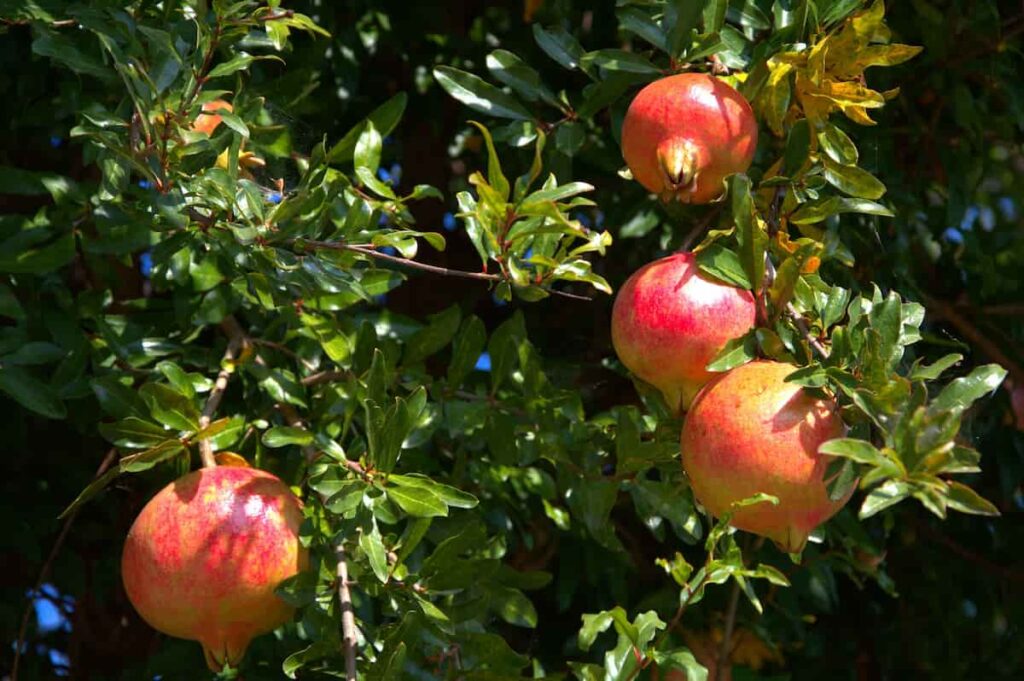
With the Pomegranate season in full swing, around 20,000 tons of the fruit has been exported from the country. India is the world’s leading producer of Pomegranates. Pomegranate-producing states in India include Maharashtra, Karnataka, Gujarat, Andhra Pradesh, Madhya Pradesh, Tamil Nadu, and Rajasthan. Land under Pomegranate cultivation in Maharashtra is 225 thousand acres, producing 9.45 lakh metric tons annually and 4.5 metric tons per acre. Maharashtra state accounts for 78% of India’s total area and 84% of its total production.
High yield hybrid Pomegranate varieties in India
Climatic and optimum soil conditions required for Pomegranate Farming
In places where the temperature drops very low during winter, the Pomegranate tree becomes deciduous. Tropical areas have evergreen trees, while subtropical areas have partially evergreen trees. Generally, Pomegranates grow best in a dry climate. When the fruit is developing and ripening, it needs hot and dry climatic conditions.
It needs a hot and dry climate in the summer and cold and dry weather in the winter. The plant cannot tolerate frost, however. Shades are not conducive to its growth. A wide range of soil types can be used for its cultivation, ranging from high-fertile to low-fertile soil. However, it produces excellent yields in a deep loamy soil. A certain degree of salinity and alkalinity can be tolerated by it. Pomegranates can also be grown on medium and black soils. Pomegranate farming requires soil with a pH range of 6.5 to 7.5.
Hybrid Pomegranate varieties that grow in India
Bhagwa
This hybrid variety is also known as Shendria, Sinduri, Astagandha, and Kesar, and it is a selection from the F2 population of the cross Ganesh x Gulesha Red. In recent years almost all the new orchards are with Bhagwa variety due to bigger fruit size, sweet, bold, attractive arils, and glossy, very attractive saffron-colored thick skin, with better keeping quality, thus making it suitable for distant markets.
This variety was found less susceptible to fruit spots and thrips than other Pomegranate varieties. ‘Bhagwa’ variety of Pomegranate is a heavy yielder (30 to 35 kg fruits per tree) and possesses desirable fruit characteristics, and matures in 180 to 190 days. Ganesh is a popular variety in Maharashtra, and it possesses pink flesh and soft seeds and is sweet with an agreeable taste and medium-sized fruits. It is also a good cropping variety.
In case you missed it: Pomegranate Pests, Diseases, and Control Methods
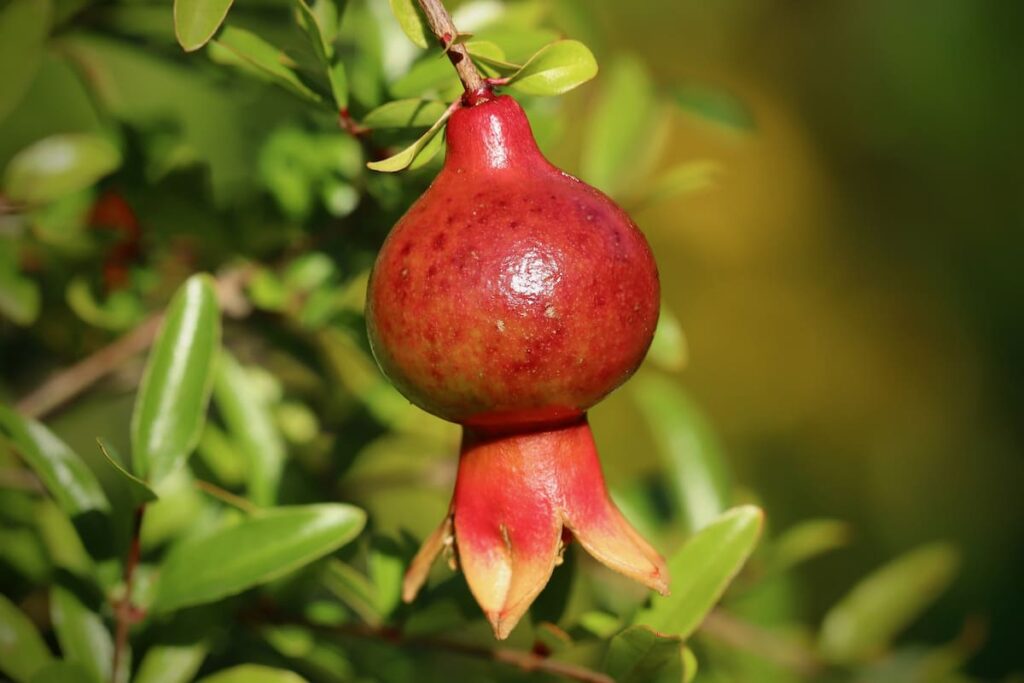
Mridula
This deep red variety has shiny skin. The seeds are deep red in color and juicy, and each fruit can weigh up to 250 to 300 grams. This variety has all the characteristics of the Ganesh variety except the arils dark red. The arils in the ‘Ambe’ Bahar and ‘Mrig’ Bahar are dark red, while it is pink during the ‘Hasta’ bahar.
This variety of Pomegranates is extremely drought tolerant. The average productivity of this variety is good, about 3.7 tons per acre. This yield is slightly lower than the top Bhagawa variety (3.9 tons per acre). Although it sets heavy crop loads, it indicates poor performance concerning quality attributes. The variety produces medium to large-sized fruits. The average fruit weight is 250 to 300 grams.
Ganesh
Although several well-recognized commercial varieties of Pomegranate are available in India, Bhagwa and Ganesh are highly preferred. This variety is developed by the selection method (selection from Alandi). It is a prolific bearer, and the fruit is medium-sized with yellow, smooth, and red tinge. Its seeds are soft with pinkish aril, and the juice tastes sweet. It is the commercial cultivar of Maharashtra. The average yield ranges from 8 to 10 kg per tree. The tree is a heavy bearer. Each fruit’s weight is about 225 to 250 grams.
Jyoti
University of Agricultural Sciences, Bengaluru, came out with Jyoti, a selection from Bassein Seedless and Dholka. Trees are dwarf and evergreen. This fruit variety has shiny skin and is yellowish red, medium to big, and its soft seeds are extremely sweet. The average fruit weight is 200 grams, and the rind develops a typical red color with pinkish-reddish colored arils. The juice percentage is 75 based on the grain’s weight. The juice has 17% total soluble solids (TSS) with a very low acidity of 0.3%.
Jalore seedless
It is a soft-seeded variety developed and recommended by CAZRI, Jodhpur, for arid regions as the fruit matures early and maximum fruit production coincides with available soil moisture during monsoon, large fruits (200g) with pink to deep red skin, arils are pink to red having soft seeds with the attractive overall appearance of the fruit.
Kandhari
Trees are deciduous, vigorous, and upright growing. It is a regular bearer with a good yield per tree. It bears fruits only during the ‘Ambe’ bahar season (April-May flowering). Fruits are big with yellow colored peel and red splash. The average fruit weight is 370 grams. Arils are light pinkish to deep pinkish, with semihard seeds, depending upon the dry weather and prevailing temperature.
The seeds can be a little hard in texture. The grains have 77 percent juice based on the weight of the grains. The juice has 13 to 15% total soluble solids (TSS) and well-blended acidity (0.5 to 0.6%). There is a considerable variation in yield from area to area. However, it can give an average yield of 4 to 5 tons per acre.
In case you missed it: Top 20 Steps to Boost Pomegranate Yield: How to Increase Pomegranate Fruit Size, Quality, and Production
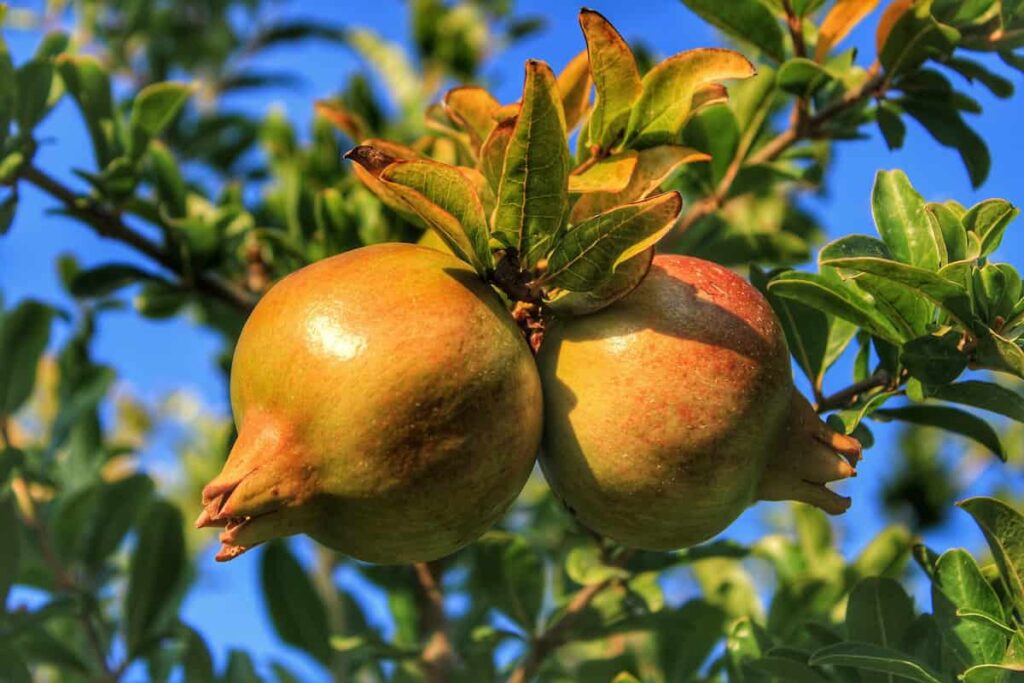
Phule Arakta
It is a selection from F-2 progeny of a cross between Ganesh x Gul-e-Shah Red, a Russian cultivar. It is reported that it has acreage next to Ganesh, the most sought-after variety among farmers. It is a heavy yielder with a fruit maturity of 130 to 140 days only. The growth habit of trees is spreading type with evergreen nature. Fruit is round, smooth, glossy, and dark brick red; arils are sweet with dark red.
Fruits are medium in size (182.70 g). The rind thickness is 0.24 cm, and its seeds are soft. Fruits are juicier (63.71%), with 15.89% total soluble solids (TSS) and 0.45% acidity. This hybrid variety fruit yield 29.83 kg per tree, 9 tons per acre, and the average number of fruits per tree is 78 to 90. The variety is suitable for both export and domestic market.
Goma Khatta
It is a hybrid between Ganesh x Daru. The hybrid has high acidity (7.3%) and bigger fruit size (137.3 grams) and is superior to Daru. The growth habit of a tree is the upright type with evergreen nature and dwarf in nature. The fruit is round, smooth, and pink with a reddish tinge. Under rainfed conditions on a five-year-old plant, a yield of 11.08 kg.
This hybrid variety fruit weight maximum in Mrig Bahar is 137.3 grams, whereas, in Ambe Bahar, it was 101.75 grams per fruit. Arils are highly acidic in taste with light pink. The juice percent showed variation, 42.8 percent in Mrig Bahar and 45.5 percent in ambe bahar. The juice’s total soluble solids (TSS) were observed to be 13.2° Brix in Mrig Bahar and 13.8 o Brix in ambe bahar.
Dholka
It is a popular variety grown in Gujarat. The fruits are large with greenish-yellow rinds. The seeds are soft and pinkish-white with a juicy, acidic taste.
Arakta
This variety grows in abundance. The fruit is big, red, and has sweet and juicy seeds. At its best, each sapling can bear up to 25 to 30 kgs of fruit. However, the fruits are smaller than the Ganesh variety having dark red-colored arils with soft seeds.
Ruby
It was developed by the Indian Institute of Horticulture Research, Bangalore, by crossing Ganesh X Kabul X Yercard. The fruits resemble the Ganesh variety with reddish brown skin with green stripes on the skin. The fruits are soft-seeded with bigger sizes and red-colored arils. It is a heavy yielder variety; average, it yields about 6.5 to 7.3 tons per acre.
Nabha
Tree growth is just like Kandhari and is also deciduous. The rind of the fruit remains yellow. The fruit size becomes larger than Kandhari if thinning is done. The average fruit weight is 350 grams. The grains are white, with hard seeds. The grains have 75 percent juice with 13% total soluble solids (TSS) and 0.5% acidity. This variety has a potential yield of 4 tons per acre.
Assam Local
Under North Indian conditions, this tree is healthy and grows up to 3 m high, and 1.5 m spread. The fruits remain free from fungal and bacterial attacks during the rainy season. It also bears fruits only one crop, and the average fruit weight is 220 grams. The arils are small, and hence juice percentage based on the weight of grains is 47, with 15% total soluble solids (TSS) and 0.6% acidity. The average yield per acre is 3 tons.
In case you missed it: Fertilizer Management in Pomegranate Trees: Organic, Homemade, Liquid, NPK, Schedule, and Application
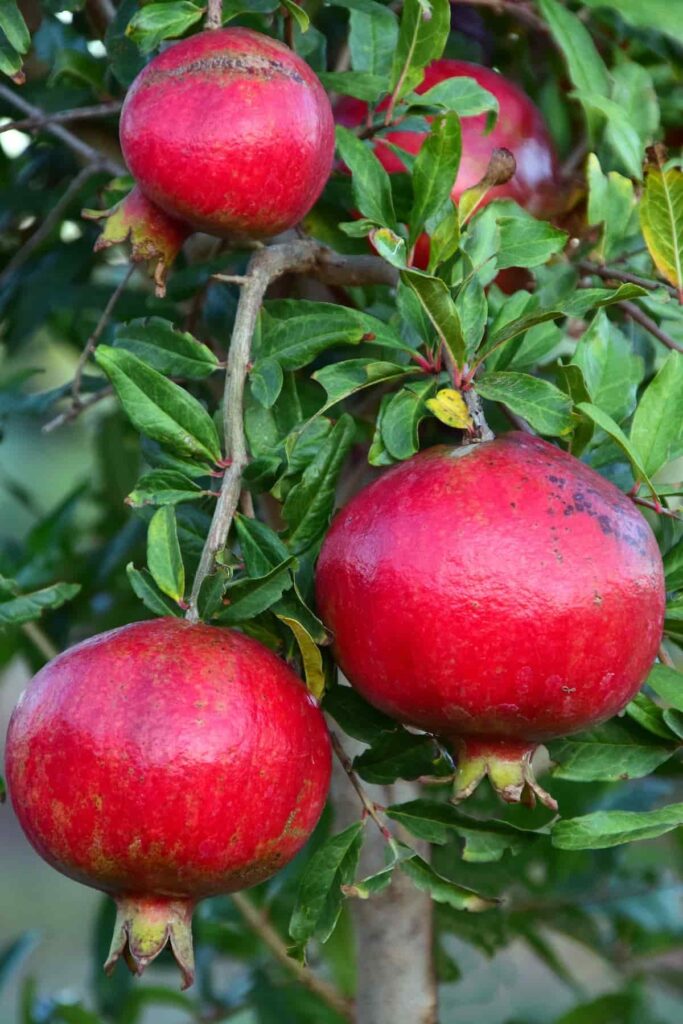
P23
Seedling selection from a traditional Muskat seedling. The fruit size is large with pinkish-white aril. Sweet in taste, and seeds are moderately hard. Grown in and around Kolhar region of Ahmednagar district in Maharashtra.
P26
A seedling selection of Muskat. The fruit size is large with a yellowish-green rind with a red tinge. Pinkish white arils, sweet in taste, and seeds are hard. It is superior to Ganesh in yield and fruit weight.
Cultivars of Pomegranate grown in different states in India
| Name of the states | Cultivars |
| Maharashtra | Ganesh, Bhagwa, G-137, P23, P26, Muskat, Mridula and Ruby |
| Andhra Pradesh | Ganesh, Bhagwa, and G-137 |
| Karnataka | Bhagwa, Jyoti and Ruby, Bassein Seedless, Madhugiri |
| Tamil Nadu | Mridula, Ganesh, Jyoti, Co-1, Yercaud, Vellodu, and Kabul Red |
| Rajasthan | Jalore seed less, Jodhpur Red, Jodhpuri White and Bhagwa |
| Gujarat | Dholka, Jalore seed less, Muskat Red, Paper Shell, and Ganesh |
| Madhya Pradesh | Jyoti and Bhagwa |
| Haryana | Ganesh, Muskat Red, Paper Shell |
The season for Pomegranate Plantation and bearing fruits
Pomegranates are planted in sub-tropical regions during the February-March months (during spring). Plantations of Pomegranates take place in the tropical areas during July and August. The most common time for air layering is during the rainy season and November-December. The southern and central parts of India have Pomegranate plants that bloom and bear fruit throughout the year. When the crop receives rainfall and precipitation, flowering occurs during these months
- January to February (Ambe Bahar)
- June to July (Mrig Bahar)
- September to October (Hasta Bahar)
Where the monsoon is normal and regular, the Mrig bahar pattern is followed, where plants flower during the monsoon months. It is only possible to flower in January if irrigation facilities are available during the summer months of April and May. On the other hand, flowering in October is profitable when comparing yields and prices. Irrigation in April is made more expensive by January flowering.
In case you missed it: Pomegranate Grafting Method; Pruning Method; Training
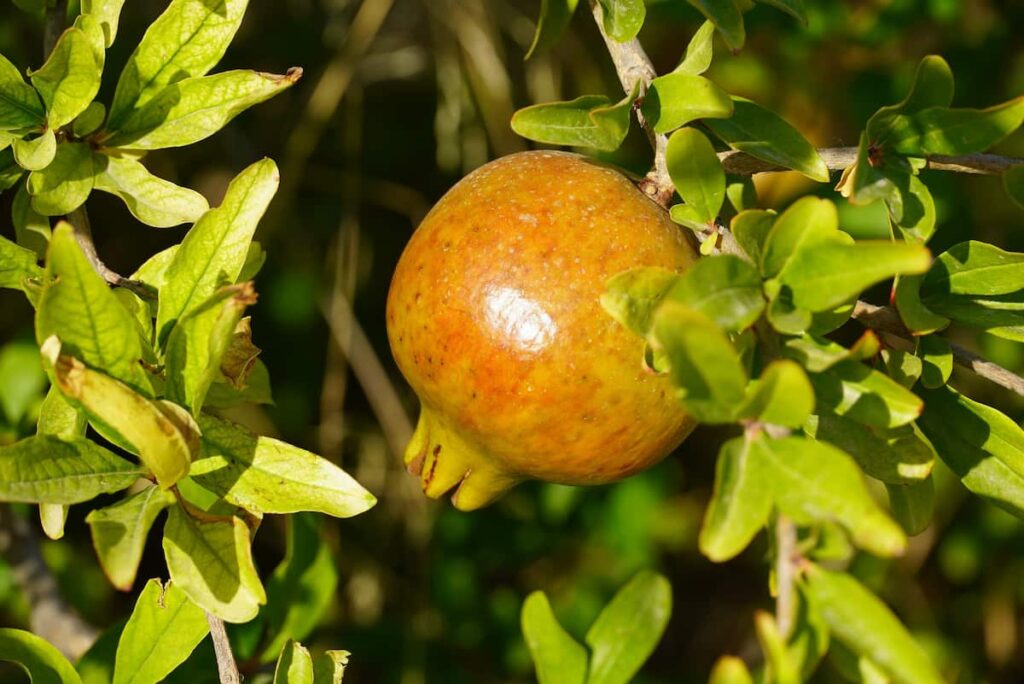
Fruits that are well-rounded and of adequate size will be obtained when one fruit is kept on each small stalk. As soon as sufficient fruits have been set, the remaining flowers are manually plucked to prevent further development. In a mature tree, a farmer can keep no more than 100 fruits.
Harvesting Pomegranate
Plants like this start fruiting after three years of planting. But commercial production should bear fruit only after five years of planting. The well-developed plant gives 60 to 80 fruits every year for 25 to 30 years. Adopting appropriate cultivating methods and the correct amount of fertilizers and manure increased by 15 to 20% will increase the yield by 50% and avoid other losses.
After 150 to 180 days from flowering to fruit maturity, Pomegranate harvesting begins. Nevertheless, it depends on the genotype, climatic conditions, and growing region. Fruit should be harvested at its optimum maturity to avoid dull, immature, and improperly ripened fruits. Late harvesting, on the other hand, increases the risk of disease attacks. As a non-climacteric fruit, Pomegranates should be harvested after they have reached the proper ripening stage.
Several harvest signs are used to determine Pomegranate fruit maturity and harvesting. Dark rose pink arils should develop on the surface, and consumers prefer dark pink arils. In Pomegranate fruits, the calyx at the bottom turns inward to indicate maturity. Aril should be turned into deep red or pink. The fruits of Pomegranates should not be overripe. Secateurs or clippers should be used when harvesting fruits in clusters because manual twisting can damage them.
Fruits should be sorted after harvesting, so diseased and cracked fruits should be removed, and healthy fruits should be selected for treatment. Fruits should be washed with 100 ppm sodium hypochlorite solution after sorting. In addition to reducing microbial contamination, this treatment will extend the product’s shelf life.
In case you missed it: Growing Pomegranate in Containers, Pots, and Backyards
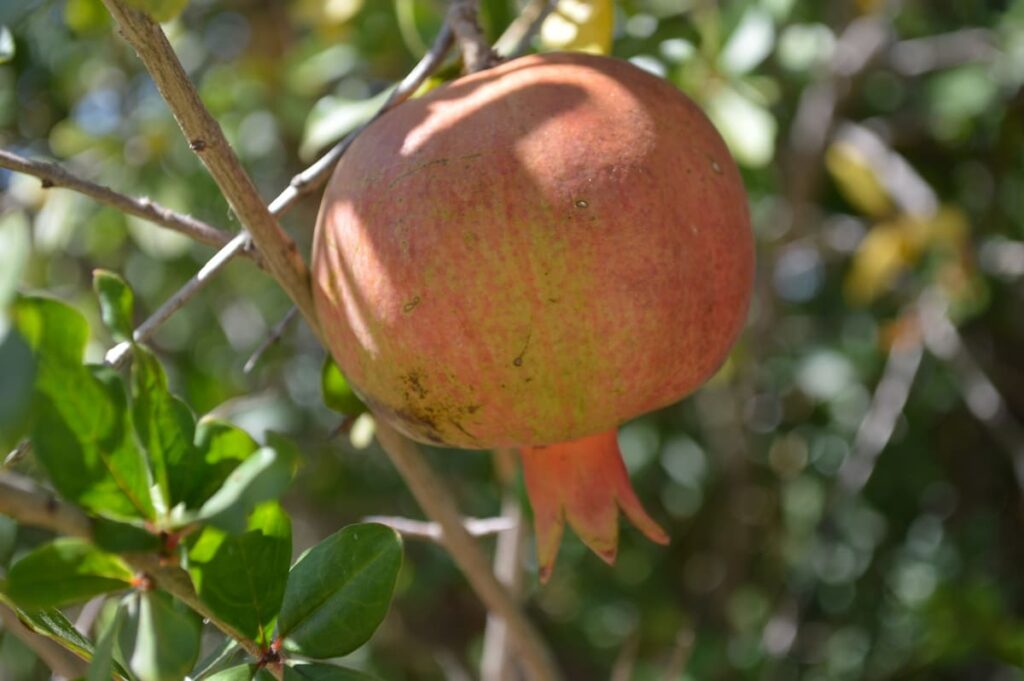
Tips to increase yield in Pomegranate farming
- Avoid cultivating Pomegranate in heavy soils as it considerably affects the fruit quality and color. Instead, well-drained sandy loam soil is considered the best for cultivating Pomegranates.
- One month before planting, dig a pit and leave it open for 15 days. After that, mix 20 kg rotten cow dung manure, 1 kg single super phosphate, and 50 g chlorpyrifos powder in the soil and fill the pits to 15 cm from the surface. Irrigate after filling the pit so that the soil freezes well. After that, plant the plants and irrigate them immediately after planting.
- After the rainy season, regular irrigation should be done at 10 to 12 days intervals for the good development of fruits. Drop-by-drop irrigation has proved useful for Pomegranate; it has seen 43% water savings and a 30 to 35% increase in yield.
- Pomegranate plants need very little pruning and cut their twigs only, so their bushes do not form. In addition, suckers growing around the stem should be removed as they compete with the main plant and reduce their effectiveness.
- Young plants need support to keep them straight and bear the load of growing shoots. Use 50 to 75-cm-long bamboo or wooden sticks and tie the main limbs at one or two places with coconut or jute strings to avoid bending and breaking the plant.
- The weeding process must be carried out manually. Two times a year, once in May and another in December, when fertilization occurs. During the monsoon season, some farmers spray 0.6% of Gramoxone. It is crucial to spray close to weeds while keeping the nozzle at a close distance to avoid chemical drift.
Conclusion
There is a significant variation in yield per acre between varieties and seasons. Therefore, choosing the suitable Pomegranate variety discussed above and sowing and harvesting times will make it easier for you to cultivate Promeganates and get high yields. In addition, these hybrid varieties produce high yields and are resistant to diseases, reducing pesticide usage costs in cultivation from seedling to harvest.
- Types of Pesticides Used in Agriculture: A Beginner’s Guide
- Economical Aquaculture: A Guide to Low-Budget Fish Farming
- 15 Common Planting Errors That Can Doom Your Fruit Trees
- How to Make Houseplants Bushy: Effective Tips and Ideas
- Innovative Strategies for Boosting Coconut Pollination and Yield
- Pollination Strategies for Maximum Pumpkin Yield
- The Complete Guide to Chicken Fattening: Strategies for Maximum Growth
- Natural Solutions for Tulip Problems: 100% Effective Remedies for Leaf and Bulb-Related Issues
- Revolutionizing Citrus Preservation: Towards a Healthier, Greener Future
- Natural Solutions for Peony Leaf and Flower Problems: 100% Effective Remedies
- Maximizing Profits with Avocado Contract Farming in India: A Comprehensive Guide
- Natural Solutions for Hydrangea Problems: 100% Effective Remedies for Leaf and Flowers
- The Ultimate Guide to Choosing the Perfect Foliage Friend: Bringing Life Indoors
- From Sunlight to Sustainability: 15 Ways to Use Solar Technology in Agriculture
- The Ultimate Guide to Dong Tao Chicken: Exploring from History to Raising
- The Eco-Friendly Makeover: How to Convert Your Unused Swimming Pool into a Fish Pond
- Mastering the Art of Delaware Chicken Farming: Essentials for Healthy Backyard Flocks
- 20 Best Homemade Fertilizers for Money Plant: DIY Recipes and Application Methods
- How to Craft a Comprehensive Free-Range Chicken Farming Business Plan
- Brighten Your Flock: Raising Easter Egger Chickens for Beauty and Bounty
- How to Optimize Your Poultry Egg Farm Business Plan with These Strategies
- Subsidy for Spirulina Cultivation: How Indian Government Schemes Encouraging Spirulina Farmers
- Ultimate Guide to Raising Dominique Chickens: Breeding, Feeding, Egg-Production, and Care
- Mastering the Art of Raising Jersey Giant Chickens: Care, Feeding, and More
- Ultimate Guide to Raising Legbar Chickens: Breeding, Farming Practices, Diet, Egg-Production
- How to Raise Welsummer Chickens: A Comprehensive Guide for Beginners
- How to Protect Indoor Plants in Winter: A Comprehensive Guide
- Ultimate Guide to Grow Bag Gardening: Tips, Tricks, and Planting Ideas for Urban Gardeners
- Guide to Lotus Cultivation: How to Propagate, Plant, Grow, Care, Cost, and Profit
- Agriculture Drone Subsidy Scheme: Government Kisan Subsidy, License, and How to Apply Online
- Ultimate Guide to Raising Araucana Chickens: Breed Profile, Farming Economics, Diet, and Care
- Bringing Hydroponics to Classroom: Importance, Benefits of Learning for School Students
- Ultimate Guide to Raising Polish Chickens: Breed Profile, Farming Economics, Diet, and Care
- Ultimate Guide to Raising Australorp Chickens: Profile, Farming Economics, Egg Production, Diet, and Care
- Silkie Chicken Farming: Raising Practices, Varieties, Egg Production, Diet, and Care
- Sussex Chicken Farming: Raising Practices, Varieties, Egg Production, Diet and Care